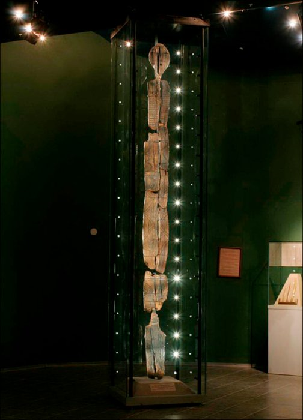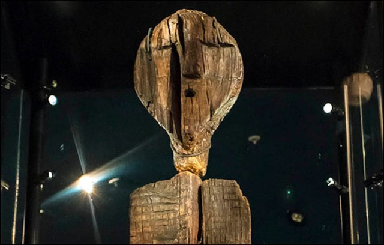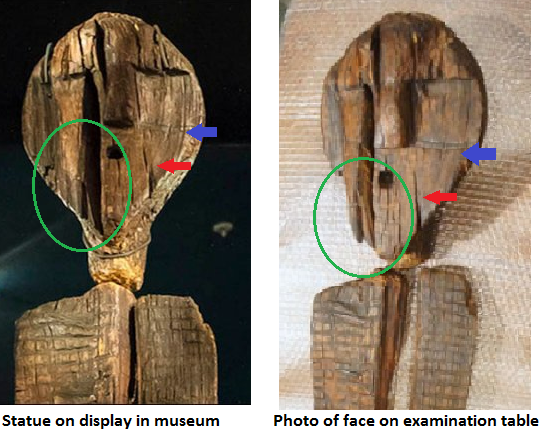![]()
.
Shigir Idol A Cloned Copy Of Alien Gray? By Ted Twietmeyer |
Idol stands in a case on display at the Yekaterinburg History Museum in Germany. It is believed to be the oldest wood statue ever found. Carved from 159 year old larch wood, it is covered with still deciphered Mesolithic era symbols. It
is believed to be approximately 9,500 years old. A grant was recently
received to fund carbon dating work to within 50 years. We will have to
wait until 2015 to have a accurate age. [1 My recent work discovered figures of two gray-like figures on the wall of the queen's chamber inside the Great Pyramid. There is little chance of mistaking the large difference between grays and human beings. Grays are well known to have a large head, thin neck, large eyes and a very small mouth.
Fig. 2 Face and neck. Keep this dark patina in mind as you read on [1] If no sealant was applied for preservation then a patina this dark requires great age. Is it possible the eyes were removed in ancient times? One counter-argument might be that ancient people were not able to carve rounded eyes. Yet this argument is refuted by the overall shape of the rounded head and neck in Fig. 3 below.
Is this a face and neck like that of a human being? Or some other being? Note how the wood has a lighter color without a patina than it did in a closeup photo apparently taken on a table in a lab (Fig. 2.) This is not possible Work is underway to decode symbols which cover the figure. What happens if the messages on the statue are inconsistent with current archeological science? Will messages found be honestly stated as they are, or covered up like many other inconvenient discoveries have been? It seems counter-intuitive to believe that with all the messages carved on it and all the detail it has, that a ancient artist would have left the eyes out.
Fig. 4 Notation graphics added by author. Russian examination table photo [2]. Slightly different cameraangles cannot explain these blatant differences. Museum display shows two metal wires which curve over the top of the forehead and another wire around the neck to hold it in place. Wires should not be mistaken as differences in the two photos. Blue and red arrows point to lines and cracks in the wood which do not match. Circled area shows different chins, with chin outline of museum version apparently restored. Clearly this is not the same statue. Is the elaborately constructed museum display a cloned copy? Did the Russians send Germany a fake idol? How many versions of this “unique” statue exist? Will Russia be apologizing to Germany before carbon dating reveals the fake? Perhaps Germany already knows the glass-enclosed version is a fake. It makes one ask how many other museum displays in Germany and around the world are fakes, but are displayed as originals. Note how the dark shiny patina is GONE in both faces of figure 4 which is clearly visible in figure 2.
Ted Twietmeyer [1] http://www.messagetoeagle.com/shigiridol.php#ixzz3HoE92pxt [2] http://rostec.ru/en/news/4514137 |
| Donate
to Rense.com
Support Free And Honest
Journalism At Rense.com |
Subscribe
To RenseRadio!
Enormous Online Archives,
MP3s, Streaming Audio Files,
Highest Quality Live Programs |
 Fig. 1 Statue stands as tall as a two story house. Compare to nearby display
case. Note how they carefully enclosed and lighted this statue.[1]
Fig. 1 Statue stands as tall as a two story house. Compare to nearby display
case. Note how they carefully enclosed and lighted this statue.[1]

